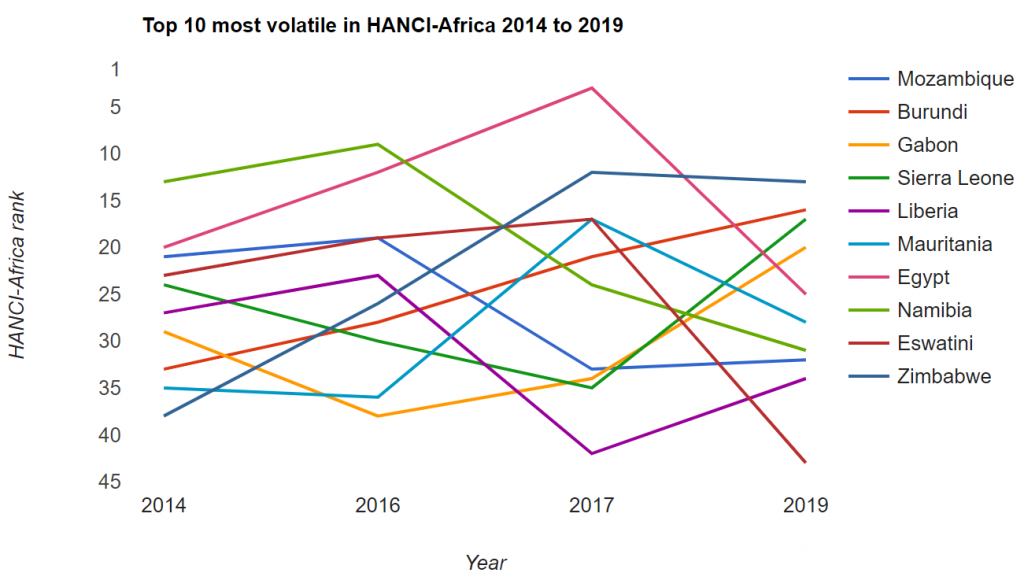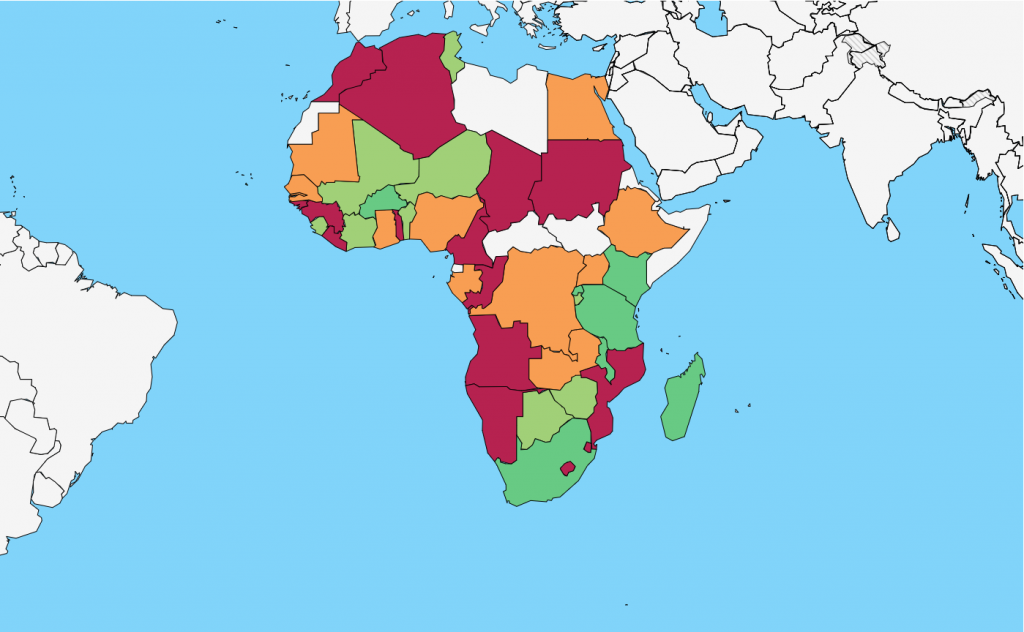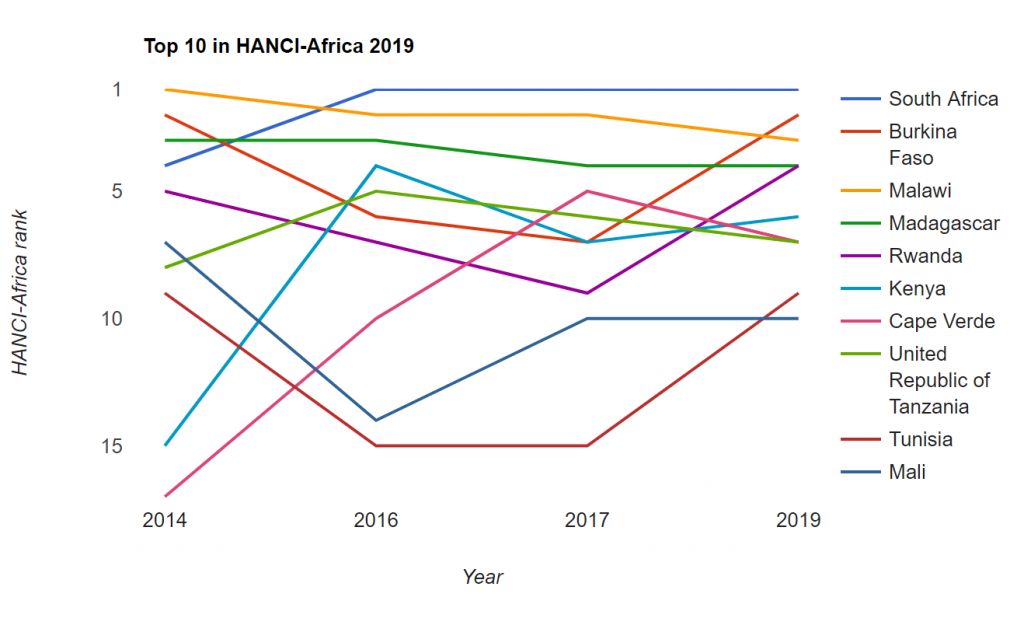FAO’s most recent State of Food Insecurity and Nutrition in the World (2020) report shows more than 250 million people were undernourished in Africa. The prevalence of undernutrition (PoU) had risen from 17.6 percent (in 2014) to 19.1 percent of the population (2019). The socio-economic effects of Covid-19 have been widely reported to have further spurred widespread food insecurity since and it is clear that African states continue to face considerable challenges fighting hunger and undernutrition.
The Africa Hunger and Nutrition Commitment Index (HANCI-Africa) seeks to record which African states demonstrate political commitment in the fight against hunger and undernutrition, to support accountability processes. It reveals African nations taking the strongest action, as well as those that have the biggest improvements to make.
This fourth iteration for 2019 shows South Africa, Burkina Faso and Malawi ranking top three positions among the 45 African countries included in the analysis.
Top 10 in the HANCI-Africa 2019
Repeating a feat from the previous two iterations of HANCI-Africa (2016; 2017), South Africa achieves the top spot in 2019. Since 2017, South Africa has strengthened outcomes across seven out of 22 indicators, including improved birth registration rates, women’s economic rights and women’s access to land. A consistent performance is also witnessed by its top three ranking in 12 out of the total 22 indicators employed in the index (see country scorecard). South Africa did however see a small reduction in health spending.
Burkina Faso is newly ranked second overall position in HANCI-Africa 2019. It improved outcomes on six indicators compared to the previous HANCI-Africa (2017), including through increased spending on health, and action towards a nutrition budget. It strengthened security of farmland tenure, and women’s access to agricultural land. People’s access to water and sanitation, and pregnant women’s access to ante-natal care however deteriorated. Weak access to improved sanitation facilities (19.4% in 2017) obstructs better hunger and nutrition outcomes.
Burkina’s rise, and no clear overall advances in its own performance have made Malawi drop from second to overall third in the HANCI-Africa rankings, between 2017 and 2019. Its performance at the top of the rankings has been steady (Fig 1). Yet, Malawi’s spending in its health sector (9.8% of public spending in 2017) does not fully meet (15%) commitments set out in the Abuja Declaration. It also provides only weak access to improved sanitation facilities, that is for just over half of its population (55.1% in 2016).
Fastest ‘Climbers and Tumblers’ in 2019
Although the top rankings are always of particular interest, we observed that several West African countries are making the fastest rank improvements in the HANCI-Africa 2019. Sierra Leone, Gabon, Benin, Nigeria and Botswana all rose 11 or more ranks. Botswana and Benin are now closing in on top ten listings, while Sierra Leone, Gabon and Nigeria moved to mid table rankings.
Benin for instance strengthened health and agricultural spending and worked towards a nutrition budget line. Security of tenure improved, as did access to water and sanitation. While women’s access to land improved, their general economic rights declined, and significantly fewer children received Vitamin A supplementation.
Fastest riser Sierra Leone strengthened spending on agriculture, women’s access to land, agricultural extension services, and elevated levels of access to water and sanitation. It also introduced a national nutrition policy. While more relatively more children obtained birth registration, relatively fewer received Vitamin A supplementation.
In contrast, Eswatini (Swaziland) dropped 26 ranks, from mid table 17th to end of table 43rd rank. Social protection systems, women’s access to land weakened, as health and agricultural spending dropped, and nutrition budget lines, policy and up to date data for policymakers weakened.
Another notable country showing decline is Egypt. While it had shown strong progress between HANCI-Africa 2014 and HANCI-Africa 2017 Egypt has since seen a precipitous decline in its ranking, from 3rd to 26th overall. This drop has been caused by a decline in government spending on agriculture, tenure security and agricultural extension services; weakening social protection systems; and women’s diminished access to land. Moreover, nutrition policy is flagging, as is up to date nutrition data to inform policymakers.
Taking stock of HANCI-Africa
Whereas volatility as shown by e.g. Egypt could potentially be an artefact of the index, as small or limited changes on key indicators trigger significant slides or elevations in the rankings, when we take stock of HANCI-Africa since its first issue in 2014, it is clear that not all countries are subject to volatility.
Fig 1: Performance of top 10 countries in HANCI-Africa 2019 (2014; 2016; 2017; 2019).
Above figure charts the temporal dynamics of HANCI-Africa ranking over the 2014-2019 period for the top 10 performers in the HANCI-Africa 2019. The top 10 status seem quite stable for most countries. For example, 8 of these 2019 top 10 countries were also in the top 10 in 2014.
Overall, most African countries with big rank changes between HANCI-Africa 2017 and HANCI-Africa 2019, as highlighted above, are also among the most volatile when considering all previous iterations of HANCI-Africa. The HANCI-Africa rank movement of the top 10 most volatile countries suggest that for almost all the movement over the 2014-2019 period has been in both directions (Fig 2). Burundi is the only exception with consistent rank improvement (from 33 in 2014 to 16 in 2019) throughout.

Fig 2: Top 10 most volatile countries in HANCI-Africa (2014; 2016; 2017; 2019).
While Africa continue to bear the biggest burden in reducing hunger and undernutrition, commitments from countries like South Africa and Malawi show that there are governments who are putting hunger and undernutrition at the centre of their policy, legal protections and spending plans. HANCI-Africa 2019, like previous iterations, underline the necessity to invest, and plan across all sectors if governments are to truly fight food deprivation and malnourishment.





Leave a Reply